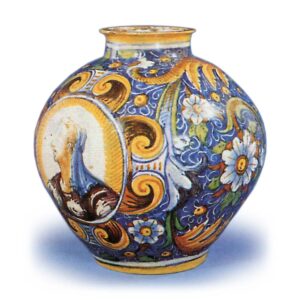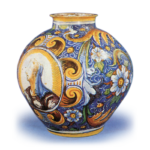
Painted ceramics produced in Italy from the early fifteenth century and made famous during the Renaissance. Most of them were painted with a white opaque tin glaze on a colored coach base. In Europe, many tin-glazed opaque wares of this type were decorated with metallic glaze paintings. The process was introduced to Spain with the expansion of Islam. The name majolica was given to this type of pottery, which had already been produced since the early Middle Ages, when it was imported to Italy from Majolica, one of its production centers. At first this name was used only for opaque glazed wares with metallic glaze, but during the Renaissance it became a common name for painted wares produced in various parts of Italy, and eventually became a synonym for Italian pottery and a very well-known term. It became a synonym for Italian pottery and a very famous term. The production areas include Urbino, Faenza, Cafagiolo, Siena, Casteldurante, Bologna, Ravenna, and Ferrara. However, from the end of the 16th century, imports of Chinese porcelain increased and began to decline, and in the 17th century, many factories closed one after another. The characteristics of the so-called “Old Majolica” were the exquisiteness of the drawings and the splendor of the colors, and the shapes and patterns of the vessels were not focused on practical use, but mainly on the beauty of the paintings on the vessels. This technique was introduced to France at the end of the 16th century and spread to Lyon, Nantes, Nevers, and other areas. From around 1870, the term majolica was also used commercially for ceramics that differed in appearance and technique from old majolica, and were decorated mainly with transparent glazes of one kind or another, or with various kinds of colored glazes. The term majolica was also used commercially for ceramics produced or imported from Japan. The majolica produced or imported into Japan is not old-fashioned Italian majolica, but belongs to the new majolica or German majolica.
The Western analogues of majolica were produced in China in ancient times. Koji ware is indeed a type of new majolica, and there are many imitations of it in Japan. The majolica with colored glaze or underglaze decoration produced exclusively in Germany and Austria in recent times is a type of faience-fine. Asahi ware, created by Wagner and Toyotachibana Ueda in the Meiji period (1868-1912), is a calcareous ware that belongs to the faience-fine category, and it marked the beginning of a new era for this type of ware, but the emphasis was still mainly on underglaze painting, and colored glaze decoration was not studied in depth. Later, Majolica-style ceramics were produced in Kyoto and Awaji. The first faience-fine wares in Europe are considered to have been made in France by Parissee Pottery.








